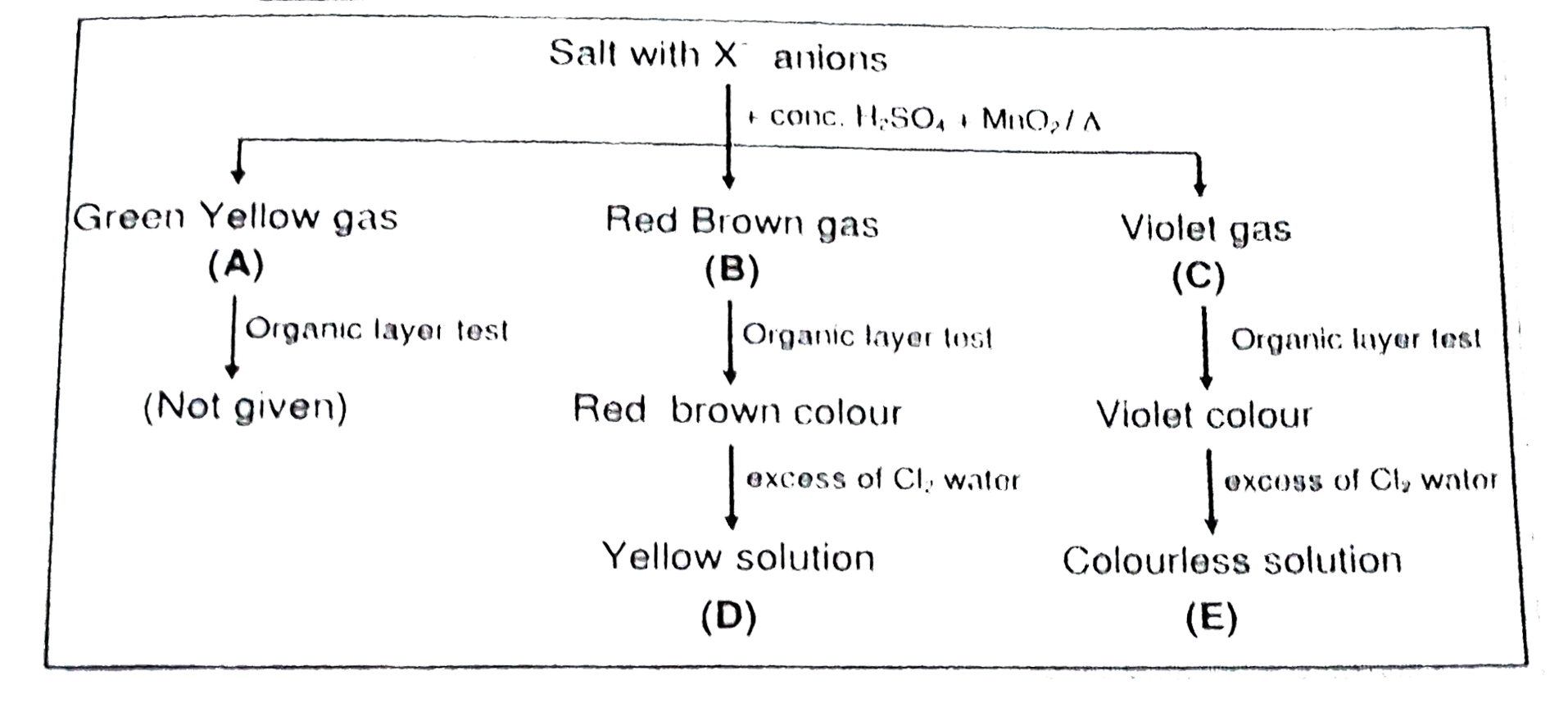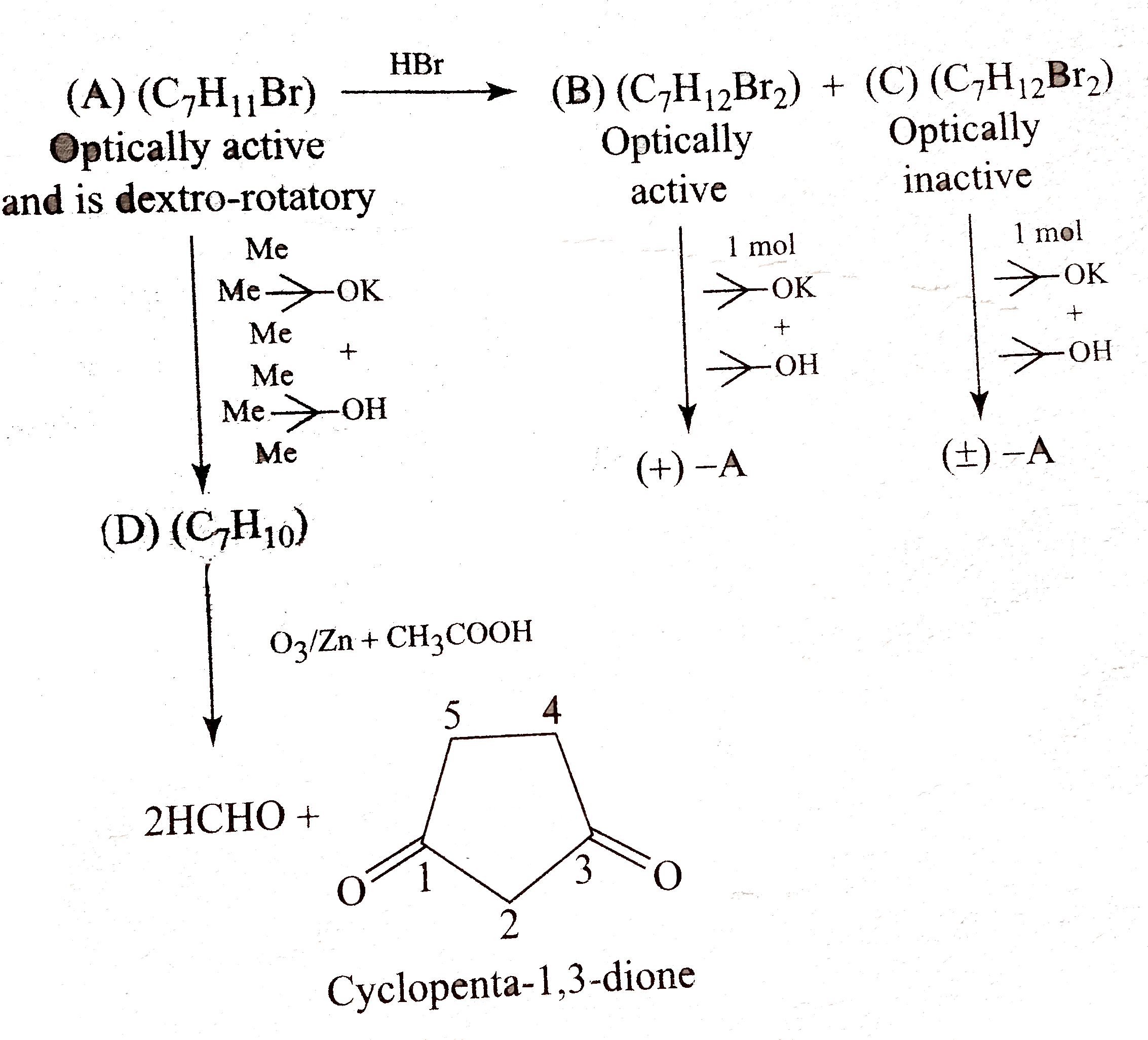On heating lead (II) nitrate gives a brown gas " A". The gas " A" on cooling changes to colourless solid "B" . Solid B on heating with NO changes to a blue solid 'C . Identify ' A', 'B' and' C and also write reactions involved and draw the structures of 'B' and 'C' .
To solve the question step by step, we will identify the compounds A, B, and C, write the relevant chemical reactions, and provide the structures for B and C.
Step 1: Identify Gas A
When lead (II) nitrate (Pb(NO3)2) is heated, it decomposes to produce lead(II) oxide (PbO) and nitrogen dioxide (NO2), which is a brown gas.
Reaction:
\( 2 \text{Pb(NO}_3\text{)}_2 \xrightarrow{\Delta} 2 \text{PbO} + 4 \text{NO}_2 + \text{O}_2 \)
Identification:
- A = NO2 (Nitrogen dioxide, brown gas)
Step 2: Identify Solid B
Upon cooling, nitrogen dioxide (NO2) dimerizes to form dinitrogen tetroxide (N2O4), which is a colorless solid.
Reaction:
\( 2 \text{NO}_2 \xrightarrow{\text{cooling}} \text{N}_2\text{O}_4 \)
Identification:
- B = N2O4 (Dinitrogen tetroxide, colorless solid)
Step 3: Identify Solid C
When dinitrogen tetroxide (N2O4) is heated with nitric oxide (NO), it forms dinitrogen trioxide (N2O3), which is a blue solid.
Reaction:
\( \text{N}_2\text{O}_4 + \text{NO} \xrightarrow{\Delta} \text{N}_2\text{O}_3 + \text{NO}_2 \)
Identification:
- C = N2O3 (Dinitrogen trioxide, blue solid)
Step 4: Draw Structures
1. Structure of B (N2O4):
- The structure of dinitrogen tetroxide (N2O4) can be represented as:
O||N−N|O|∣O
- Each nitrogen (N) is bonded to two oxygen (O) atoms, with one nitrogen forming a single bond and the other forming a double bond with oxygen.
2. Structure of C (N2O3):
- The structure of dinitrogen trioxide (N2O3) can be represented as:
O||N−N|O|O
- In this structure, one nitrogen is bonded to two oxygen atoms (one double bond and one single bond), while the other nitrogen is bonded to one oxygen atom (double bond).
Summary of Identifications:
- A = NO2 (Nitrogen dioxide, brown gas)
- B = N2O4 (Dinitrogen tetroxide, colorless solid)
- C = N2O3 (Dinitrogen trioxide, blue solid)
When lead (II) nitrate (Pb(NO3)2) is heated, it decomposes to produce lead(II) oxide (PbO) and nitrogen dioxide (NO2), which is a brown gas.
\( 2 \text{Pb(NO}_3\text{)}_2 \xrightarrow{\Delta} 2 \text{PbO} + 4 \text{NO}_2 + \text{O}_2 \)
- A = NO2 (Nitrogen dioxide, brown gas)
Upon cooling, nitrogen dioxide (NO2) dimerizes to form dinitrogen tetroxide (N2O4), which is a colorless solid.
\( 2 \text{NO}_2 \xrightarrow{\text{cooling}} \text{N}_2\text{O}_4 \)
- B = N2O4 (Dinitrogen tetroxide, colorless solid)
When dinitrogen tetroxide (N2O4) is heated with nitric oxide (NO), it forms dinitrogen trioxide (N2O3), which is a blue solid.
\( \text{N}_2\text{O}_4 + \text{NO} \xrightarrow{\Delta} \text{N}_2\text{O}_3 + \text{NO}_2 \)
- C = N2O3 (Dinitrogen trioxide, blue solid)
1. Structure of B (N2O4):
- The structure of dinitrogen tetroxide (N2O4) can be represented as:
O||N−N|O|∣O
- Each nitrogen (N) is bonded to two oxygen (O) atoms, with one nitrogen forming a single bond and the other forming a double bond with oxygen.
- The structure of dinitrogen trioxide (N2O3) can be represented as:
O||N−N|O|O
- In this structure, one nitrogen is bonded to two oxygen atoms (one double bond and one single bond), while the other nitrogen is bonded to one oxygen atom (double bond).
- A = NO2 (Nitrogen dioxide, brown gas)
- B = N2O4 (Dinitrogen tetroxide, colorless solid)
- C = N2O3 (Dinitrogen trioxide, blue solid)
Topper's Solved these Questions
- BOOK - NCERT EXEMPLAR ENGLISHCHAPTER - P-BLOCK ELEMENTSEXERCISE - Assertion and Reason6videos
P-BLOCK ELEMENTS
- BOOK - NCERT EXEMPLAR ENGLISHCHAPTER - HALOALKANES AND HALOARENESEXERCISE - Long Answer Type Questions3videos
HALOALKANES AND HALOARENES
- BOOK - NCERT EXEMPLAR ENGLISHCHAPTER - POLYMEREXERCISE - Long Answer Type Question5videos
POLYMER
Similar Questions

Identify the gas A, B and C.View SolutionIdentify [A][B] and [C] and gives the complete chemical reactions involved.
 View Solution
View SolutionGive the stereochemical forculae for (A),(B)(C), and (D) and also give the reactions involved.
 View Solution
View SolutionAn element A reacts with water to form a compound B which is used in white washing. The compound B on heating forms an oxide C which on treatment with water gives back B. Identify A, B and C and give the reactions involved.
View Solution(a) When concentrated sulphuric acid was added to an unknown salt present in a test tube a brown gas (A) was evolved . This gas intensified when copper turnings were added to this test tube . On cooling, the gas (A) changed into a colourless solid (B) .
(i) Identify (A) and (B).
(ii) Write the structures of (A) and (B).
(iii) Why does gas (A) change to solid on cooling ?
(b) Arrange the following in the decreasing order of their reducing character :
HF , HCl , HBr , HI
(c) Complete the following reaction :
XeF4+SbF5→View SolutionLead nitrate on heating gives A, A on cooling give B, NO with B give C(blue solid). Find oxidation no of N in compound C
View SolutionZinc on reaction with NaOH gives a salt (A) along with a gas (B).
(A) on reaction with H2S gas gives a white precipitate (C ).
Identify (A), (B) and (C ).View SolutionWhen a brown compound of manganese (A) is treated with HCl it gives a gas (B). The gas taken in excess, reacts with NH3 to give an explosive compound (C ). Identify compound A, B and C.
View SolutionCaCO3 on heating gives a white solid (A) and a gas (B), (A) on heating with carbon gives a solid (C) and a gas (D), (C) on hydrolysis glves a gas (E) and a solid (F) Identify (A), (B), (C), (D) , (E) and (F) .
View SolutionMagnesium on heating in air gives (A) and (B). On reaction with water (B) gives a colourless gas (C).(C) when passed through CuSO4 solution, gives a blue coloured solution (D). Identify (C)
and (D).View Solution

